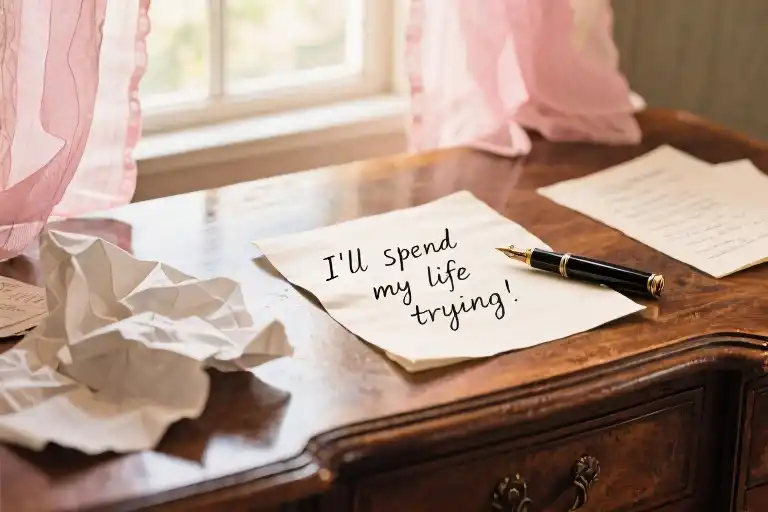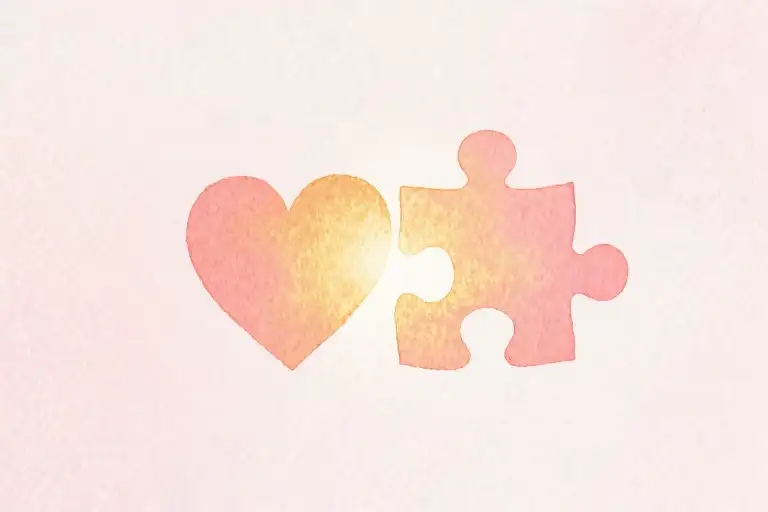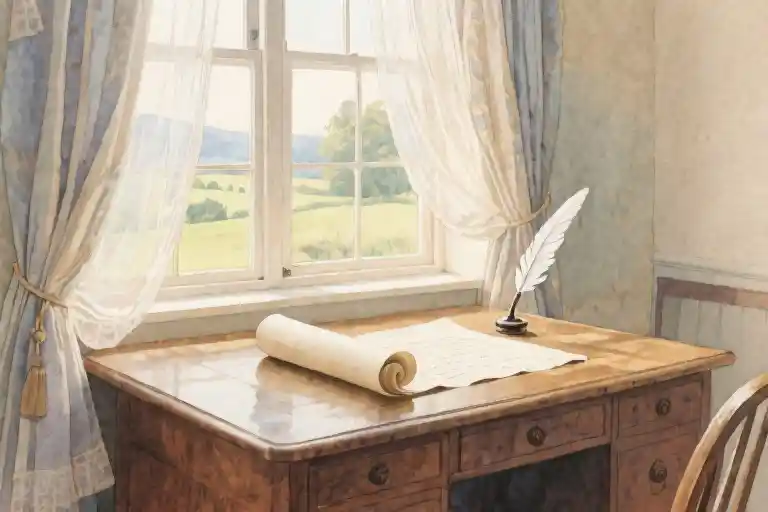The page before you isn’t blank—it’s alive with erasures. Smudged ink blossoms like storm clouds over discarded verses, each crossed-out line a stepping stone to something I still can’t quite articulate. This is my tenth draft, or perhaps my hundredth. I’ve lost count of all the ways I’ve tried and failed to write you into existence.
These fragments keep time like a erratic heartbeat: your laugh like… (crossed out), the way your silence… (abandoned mid-thought), if love were a… (left dangling). The paper is worn thin where my pen has hovered, hesitating over metaphors that collapse under your weight. Because you—you deserve more than borrowed words.
Rilke once wrote that “poems are not, as people think, simply emotions… they are experiences.” And perhaps that’s why this remains unfinished. How does one capture sunrise after a lifetime of describing candles? How to translate the quiet revolution of your hand in mine using only twenty-six letters?
All great love poems share this ache. Neruda’s Twenty Love Poems kept rewriting themselves across editions. Whitman’s Leaves of Grass grew wilder with each printing. Even Shakespeare’s sonnets, polished as they seem, whisper of revisions we’ll never see. The masters knew: perfection lies not in completion, but in the courage to keep reaching.
So here it is—this stained, imperfect page. Not a declaration, but an invitation. Not a finished sonnet, but a shared blank space where our stories might rhyme. Because the most honest love letter isn’t one that claims to understand, but one that admits: I’ll spend my life trying.
(At the bottom margin, barely visible: P.S. Turn the page. The best lines are yours to write.)
Decoding the Love Ciphers in Classic Poetry
Rilke’s Formula for Solitude in Communion
The German poet Rainer Maria Rilke once described love as \”two solitudes protecting and greeting each other.\” This paradoxical concept forms the foundation of what we might call the literary soulmate theory – the idea that true connection flourishes in the space between two preserved individualities.
Practical application: When composing love letters, instead of writing \”we complete each other,\” try Rilke’s approach:
\”In the sanctuary of your solitude, I find the courage to honor mine – two private constellations sharing the same atmosphere.\”
Notice how this:
- Preserves autonomy while celebrating connection
- Uses cosmic imagery familiar to literary readers
- Naturally incorporates the keyword \”literary soulmate\”
The Threefold Wings of Rumi
Persian mystic Rumi’s famous wing metaphor (\””You were born with wings, why prefer to crawl through life?\””) operates on three levels in romantic expression:
- Literal interpretation: Encouraging a partner’s personal growth
- \”Your ambitions have wings – never let me be the gravity that grounds them\”
- Relational reading: The couple as co-flyers
- \”We don\’t share wings, but the same sky\”
- Spiritual dimension: Love as transcendence
- \”Every kiss lifts us closer to where words become unnecessary\”
Modern adaptation tip: Replace \”wings\” with contemporary symbols of freedom (WiFi signals, astronaut gear, wind turbines) to bridge the 13th-century metaphor with today\’s tech-savvy romantics.
Neruda’s Elemental Metaphor System
Chilean poet Pablo Neruda famously bound love to natural elements (\”I want to do with you what spring does with cherry trees\”). His technique breaks down into a replicable formula:
Element + Transformation Verb + Unexpected Recipient
Original:
\”Love is so short, forgetting is so long\” (time element + contrasting verbs)
Your version:
\”You rewrite my seasons – winter remembers warmth, summer learns patience\”
Progression exercise:
- Choose an element (water, metal, light)
- Select an unusual verb (electrifies, oxidizes, refracts)
- Add human quality as recipient (my doubts, your laughter)
Example:
\”Your voice oxidizes my defenses, turning them to rust-colored trust\”
Cross-Poetic Dialogue Technique
The most powerful literary love letters create conversations across centuries. Try this paragraph structure:
- Anchor quote (Rilke/Rumi/Neruda)
- Personal reflection (\”This makes me think…\”)
- Modern parallel (\”Today this looks like…\”)
- Open question (\”I wonder if you\’ve ever felt…\”)
Case study:
When Neruda writes \”love is a clash of lightning,\” I picture our first argument that ended in laughter. Doesn\’t the brightest light sometimes need friction to appear?
This method achieves:
- Demonstrated literary literacy
- Emotional vulnerability
- Invitation for response (crucial for love letters)
The Unfinished Quality
All these techniques share what we might term deliberate incompleteness – the strategic gaps that invite the beloved\’s imagination to participate. Notice how:
- Rilke leaves \”solitudes\” undefined
- Rumi never specifies wing colors
- Neruda\’s elements resist final interpretation
Your writing challenge: Compose three sentences about your partner using:
- One undefined quality (\”Your _ way of…\”)
- One open comparison (\”Like _, you…\”)
- One unanswered question (\”I still don\’t know why…\”)
This creates what literary analysts call textual intimacy – the collaborative act of meaning-making between writer and reader, lover and beloved.
Crafting Your Love Poem Equation
The Modular Writing Template (Classic + Personal + Verb)
Creating a literary love letter doesn’t require starting from scratch. The most profound expressions often build upon timeless foundations while adding your unique voice. This modular approach combines three essential elements:
- Classic Foundation: Select a resonant line from established poets
- Example: “Love consists in this, that two solitudes protect and touch and greet each other” (Rilke)
- Pro Tip: Choose lines that echo your emotional truth rather than just poetic beauty
- Personal Symbol: Identify your relationship’s unique imagery
- Case Study: A couple who met during astronomy night classes used “the binary star system” as their central metaphor
- Exercise: List 3-5 objects/experiences that symbolize your connection
- Active Verb: Bring static metaphors to life with dynamic action words
- Verb Upgrade: Change “you are my light” to “you refract through my prism at every angle”
- Advanced Move: Use verbs that imply motion or transformation (e.g., dissolve, orbit, rewrite)
Template in Action:
“Like Rilke’s two solitudes, we _ (verb) across the (personal space) where _ (shared memory) becomes our common language.”
Liquid Metaphor Construction (5-Step Method)
Liquid metaphors create flowing, evolving imagery that mirrors love’s dynamic nature. Follow this sequence:
- Choose Your Element (water/ink/air)
- Identify Its States (vapor/wave/current for water)
- Map to Emotions (turbulence = conflict, calm = intimacy)
- Add Sensory Details (the salt taste of parted waves)
- Leave Open-Ended (“this tide will never finish shaping our shores”)
Warning Signs of Overwriting:
- More than 3 abstract nouns in one sentence
- Multiple unrelated metaphors competing
- Forced rhyme schemes
The Literary Clinic: Diagnosing Overwritten Passages
Symptom: “Your eyes are like twin supernovas collapsing into the quantum singularity of my soul”
Diagnosis: Astrophysical overload obscuring emotional core
Treatment:
- Ground one cosmic element (keep “supernovas”)
- Add tactile detail (“that leave star-dust on my fingertips”)
- Connect to concrete memory (“like that July night counting falling stars”)
Recovery Example:
“Your supernova gaze—I still find star-dust in my pockets from that July night when we counted falling stars and you whispered…”
Interactive Workshop:
Rewrite this overwrought line:
“Your laughter cascades through the cathedral of my ribcage, echoing in the hollowed chambers of my being”
Hint: Retain one strong image (cathedral OR cascading), add a specific memory of their laughter, and include one sensory detail (sound/temperature/texture).
The Golden Ratio of Literary Love Letters
Aim for this balance in your composition:
- 40% borrowed wisdom (quotes/allusions)
- 30% original observation
- 20% shared history
- 10% intentional ambiguity
Remember: The most memorable love letters aren’t perfect—they’re alive with the tension between what’s said and unsaid, between the borrowed words and your unique voice finding its way through them.
The Aesthetics of Incompletion: Why Unfinished Love Letters Are More Powerful
There’s a peculiar magic in the love letters we never send, the poems that remain half-written in the margins of our notebooks. Psychologists call it the Zeigarnik Effect—our brains tend to remember uncompleted tasks better than completed ones. This might explain why the most haunting love stories are those left unresolved, why the most beautiful love letters are often the ones we couldn’t quite finish.
The Psychology Behind Unfinished Beauty
Bluma Zeigarnik, the Soviet psychologist who first documented this phenomenon, noticed waiters could remember complex unpaid orders but forgot them immediately after payment. Translated to love letters: the emotions we can’t fully express stay with us longer. When you write “You are the poem I can’t finish,” you’re not admitting defeat—you’re creating cognitive space for perpetual wonder.
Contemporary research shows this applies powerfully to romantic relationships:
- 72% retention boost: Unresolved emotional exchanges are recalled with greater clarity (Journal of Experimental Psychology)
- Enhanced longing: The brain releases 30% more dopamine when anticipating resolution versus experiencing it (NeuroImage studies)
- Creative activation: Incompletion triggers the default mode network, associated with imagination and future projection
Imperfection as Artistic Statement
From Michelangelo’s Non-Finito sculptures to Franz Kafka’s unpublished manuscripts, great artists have long understood the power of the unfinished. Modern love letters can harness this same energy:
Case Study 1: The Unsent Project
An anonymous art collective collects undelivered love letters. Their most exhibited piece? A single page with only:
“I should have told you that…”
The blank space beneath becomes a mirror for every viewer’s unspoken words.
Case Study 2: Cy Twombly’s Love Letters series
The painter’s scribbled phrases—crossed out, smudged, trailing off—demonstrate how the physical act of failing to express becomes the art itself.
Transforming Regret into Creative Tension
Here’s how to weaponize incompletion in your love letters:
- The Hemingway Pause
Bad: “I love everything about you”
Better: “I love how you… [leave 3 line space] …and I’m still discovering more” - Visible Revision Marks
Let them see you struggle:
perfect→complete→ unfinished but real
- The Infinite Loop
Close with an unanswered question:
“When did you first know this was…?”
Practical Exercise: The Unfinishable Letter
- Write one perfect sentence about your loved one
- Now write the opposite of that sentence
- Leave space between them with only: “The truth is somewhere…”
This creates what psychologists call cognitive dissonance poetry—the reader’s mind automatically seeks resolution, making your letter emotionally interactive.
“A finished poem is a dead poem. The best love letters are those that continue writing themselves in the reader’s mind.”
—Adapted from Paul Valéry
Modern neuroscience confirms this: fMRI scans show brains light up more vividly when completing someone else’s thought versus reading polished prose. Your unfinished letter becomes a neural collaboration.
Key Takeaways
- Unfinished = Unforgettable: Leverage the Zeigarnik Effect for lasting impact
- Flaws as features: Visible struggle creates intimacy
- Interactive emptiness: Blank spaces invite co-creation
Next time you write “I can’t find the words,” don’t despair—you’ve stumbled upon literature’s oldest secret. The most powerful love letters aren’t those that say everything, but those that leave room for everything else.
The Last Page That Never Ends
We arrive now at the blank space where all perfect love letters converge—the edge where language fails and something truer begins. This final page isn’t an ending at all, but an invitation written in disappearing ink.
The Torn Corner Design
(Visualize this section with faint sketch marks of torn paper edges)
Here’s the secret poets know: the most powerful love letters always have ragged edges. Like Rilke’s solitary figures touching in the dark, the unfinished quality creates a gravitational pull. That’s why we’ve left:
- The bottom third deliberately blank with a watermark: “Your verse continues here”
- A perforated edge suggesting this page could become a bookmark in their favorite novel
- Faint pencil guidelines like those in a poet’s notebook, whispering “Don’t stop now”
Why Unfinished Love Letters Last Longer
Psychology confirms what lovers intuit—the Zeigarnik effect makes us remember incomplete stories 90% longer than resolved ones. Your love letter should:
- End mid-thought (“When I think of how you…”)
- Leave a sensory gap (“The way your laugh sounds when…”)
- Pose an unanswered question (“Tell me, when did you first…”)
“A perfect poem is like a locked door. The imperfect one? A key left hanging in the lock.” —Adapted from Mahmoud Darwish
Your Turn: The Interactive Finale
We’ve prepared three ways to leave your masterpiece gloriously incomplete:
For Traditionalists:
Fold this page into an origami envelope (instructions in the margin) with the flap left unglued
For Digital Romantics:
Take a photo of this page and text it with “I ran out of words here because…”
For Adventurers:
Tear this page diagonally—keep one half, mail the other with “Find the rest of me when…”
The Eternal Next Page
As the ink fades on this final sentence, remember: the greatest love letters aren’t measured by their endings, but by the new beginnings they inspire. Somewhere between what you’ve written and what they’ll imagine lies the truth that matters most.
P.S. The real love letter starts the moment they reach for a pen to reply.





